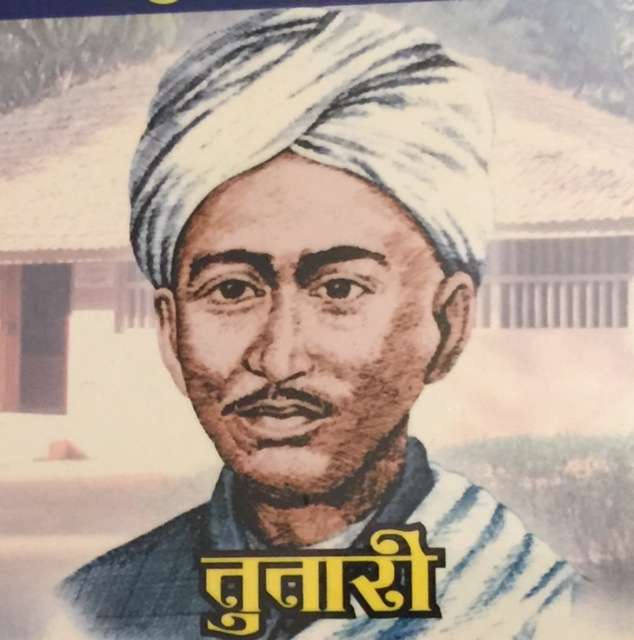Keshavasuta

Krishnaji Keshav Damle (Marathi: कृष्णाजी केशव दामले) (March 15, 1866 - November 7, 1905) was a Marathi poet from Maharashtra, India, who wrote poetry under the pen name Keshavasuta or Keshavsut (केशवसुत).[1]
Life
Damle was born on March 15, 1866 in the town of Malgund near Ratnagiri. His house has been preserved a museum—Keshavsut Smarak—in Malgund near Ganpatipule. There is a short video of that house. The house is also pictured in the photo on the right.
He attended high schools in four different towns at different times: Baroda, Wardha, Nagpur, and Pune. He registered in 1884 at New English School in Pune, where patriots Bal Gangadhar Tilak, Gopal Ganesh Agarkar, and a few others were then serving as teachers. These Indian independence activists inspired nationalism in Damle.
We may gather that he had a morose face (as a student) based on a poem he wrote titled Face of the Poet. In the poem, he wrote that a teacher in school mocked him in front of the class for having a morose face, and he replied that when he is well-known as a poet will they ask "how was the face of the poet?" He wrote poems against the caste system also. And this poem, Face of the Poet, can be seen as a poem against "lookism".
In his high school, Damle was good at Marathi, English, and Sanskrit languages, but very weak in mathematics. He could thus pass the high school matriculation examination only at his third attempt at age as late as 23. Disappointed, Damle terminated his formal education, and then undertook various low-paying jobs through the rest of his short life to support himself and his family.
Keshavsut and his brothers were intellectually accomplished, and they perhaps achieved greater success than him in their lifetimes. One brother, Moro Keshav Damle wrote a 1,000 page book which is the first scientific grammar of Marathi language (Shastriya Marathi Vyakaran, 1911); and another brother (Sitaram Keshav Damle) was a journalist who helped edit the newspaper, Kesari.
Keshavsut had settled in Bombay and his literary career was doing well there (as he was in touch with some noted editors). But fear of plague (a disease that used to hit Bombay with some regularity) caused him to leave Bombay with his family to go to Hubli. Ironically, Keshavsut, his wife, and one daughter all caught the plague (after leaving Bombay), and they all three died of this disease [Source: Family history related by Keshavsut's sister]. Keshavsut succumbed to a plague epidemic in 1905 at the age of 39.
Works
Mr. Damle wrote 132 poems. They were posthumously published eleven years after his death as Keshavasutanchi Kawita (केशवसुतांची कविता) by his younger brother Sitaram Keshav Damle.
Before Damle began composing his poems, Marathi poetry was primarily of the religious genre. He introduced to Marathi language poetry which was pioneering in two respects: Its themes and its language. He chose for his poetry themes of five kinds: romance, love of family, love of nature, love of nation, and poetry itself. He also used, unlike poets of the earlier generations, Marathi which was much more easily comprehensible to the reading public of his times.
His poem Khidakikade Mauj Pahavayas (खिडकीकडे मौज पहावयास) received publication in 1885 when he was 19. He wrote his last poem Harapale Shreya (हरपले श्रेय) in 1905, six months before his death. With only such few poems written by him, and most of them published only posthumously, Keshavsut is still known as the father of Modern Marathi Poetry. He ushered a renaissance in Marathi poetry by writing about themes of love, patriotism, freedom, against the caste system, celebration of self-expression, and beauty. Perhaps his best known poem is Tutari (Trumpet). In this poem, Keshavsut encouraged fight for independence against the British rule in India. According to Pratilipi, Keshavsut achieved through his revolutionary poems what Gopal Ganesh Agarkar achieved through his essays, and Hari Narayan Apte achieved through his novels.
Keshavsut in Contemporary Popular Culture
Keshavsut's poem Tutari is seen in the soundtrack of the Oscar-nominated film Harishchandrachi Factory.
References
- ↑ Macave, Prabhakara. "Keshavsut". Sahitya Akademi. Retrieved April 25, 2016.